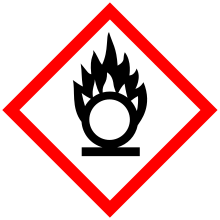Sodium iodate
Sodium iodate (NaIO3) is the sodium salt of iodic acid. Sodium iodate is an oxidizing agent, and as such it can cause fires upon contact with combustible materials or reducing agents.
 | |
| Names | |
|---|---|
| Other names
Iodic acid, sodium salt | |
| Identifiers | |
3D model (JSmol) |
|
| ChemSpider | |
| ECHA InfoCard | 100.028.793 |
| EC Number |
|
PubChem CID |
|
| RTECS number |
|
| UNII | |
CompTox Dashboard (EPA) |
|
| |
| |
| Properties | |
| INaO3 | |
| Molar mass | 197.891 g·mol−1 |
| Appearance | White orthorhombic crystals |
| Odor | Odorless |
| Density | 4.28 g/cm3 |
| Melting point | 425 °C (797 °F; 698 K) (anhydrous) decomposes[1] 19.85 °C (67.73 °F; 293.00 K) (pentahydrate) |
| 2.5 g/100 mL (0 °C) 8.98 g/100 mL (20 °C) 9.47 g/100 mL (25 °C)[2] 32.59 g/100 mL (100 °C)[3] | |
| Solubility | Soluble in acetic acid Insoluble in alcohol |
| Solubility in dimethylformamide | 0.5 g/kg[2] |
| −53.0·10−6 cm3/mol | |
| Structure | |
| Orthorhombic | |
| Thermochemistry | |
Heat capacity (C) |
125.5 J/mol·K[2] |
Std molar entropy (S |
135 J/mol·K[2] |
Std enthalpy of formation (ΔfH⦵298) |
−490.4 kJ/mol[2] |
Gibbs free energy (ΔfG˚) |
35.1 kJ/mol[2] |
| Hazards | |
| GHS pictograms |    |
| GHS Signal word | Danger |
GHS hazard statements |
H272, H302, H317, H334[4] |
| P220, P261, P280, P342+311[4] | |
| NFPA 704 (fire diamond) | |
| Lethal dose or concentration (LD, LC): | |
LD50 (median dose) |
108 mg/kg (mice, intravenous)[2] |
| Related compounds | |
Other anions |
Sodium iodide Sodium periodate Sodium bromate Sodium chlorate |
Other cations |
Potassium iodate Silver iodate |
Except where otherwise noted, data are given for materials in their standard state (at 25 °C [77 °F], 100 kPa). | |
| Infobox references | |
Preparation
It can be prepared by reacting a sodium-containing base such as sodium hydroxide with iodic acid, for example:
It can also be prepared by adding iodine to a hot, concentrated solution of sodium hydroxide or its carbonate:
Reactions
Sodium iodate can be oxidized to sodium periodate in water solutions by hypochlorites or other strong oxidizing agents:
Uses
The main use of sodium iodate in everyday life is in iodised salt. The other compounds which are used in iodised table salt are potassium iodate, potassium iodide, and sodium iodide. Sodium iodate comprises 15 to 50 mg per kilogram of applicable salt.
Sodium iodate is also used as a dough conditioner to strengthen the dough.
Safety
Conditions/substances to avoid are: heat, shock, friction, combustible materials, reducing materials, aluminium, organic compounds, carbon, hydrogen peroxide, sulfides.
References
- Lide, David R. (1998). Handbook of Chemistry and Physics (87 ed.). Boca Raton, Florida: CRC Press. pp. 4–85. ISBN 0-8493-0594-2.
- http://chemister.ru/Database/properties-en.php?dbid=1&id=759
- Seidell, Atherton; Linke, William F. (1919). Solubilities of Inorganic and Organic Compounds (2nd ed.). D. Van Nostrand Company.
Results here are multiplied by water's density at temperature of solution for unit conversion. - Sigma-Aldrich Co., Sodium iodate. Retrieved on 2014-05-25.
